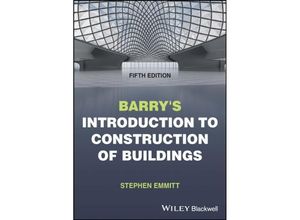Authoritative well established comprehensive practical and highly illustrated guide to
construction practice Since 1958 Barry's Construction of Buildings has served as a standard
guide to building practices and construction skills. The first volume of this now two-volume
format Barry's Introduction to Construction of Buildings provides the basic material an
undergraduate student will need to understand how the majority of low-rise buildings are
constructed. The text explains construction technology through key functional and performance
requirements for the main elements common to all buildings. The material in the Fifth Edition
has been updated to ensure it covers the latest building regulations and current construction
technology with particular attention paid to the decisions required on what and how to build
to achieve a low carbon resilient built environment. Design technology site assembly and
environmental issues are all covered showing how buildings that are more efficient with lower
embodied carbon are constructed. New 'in chapter' questions better facilitate self-reflection
and learning. Barry's Introduction to Construction of Buildings contains information on: *
General principles of construction regulations and approvals making choices and sources of
information and responding to climate change * Site analysis setup security bedrock and
soil types ground stability drainage strip pad and raft foundations and scaffolding *
Functional requirements for floors including ground-supported concrete floor slabs timber
upper floors floor finishes and suspended timber ground floors * Pitched roofs and their
coverings sheet metal covering to low-pitched roofs flat roofs thermal insulation in flat
roofs parapet walls and green roofs Barry's Introduction to Construction of Buildings is an
ideal learning resource for undergraduate students and those working towards similar NQF level
5 and 6 qualifications in building and construction. This title is a companion to Barry's
Advanced Construction of Buildings Fifth Edition.

